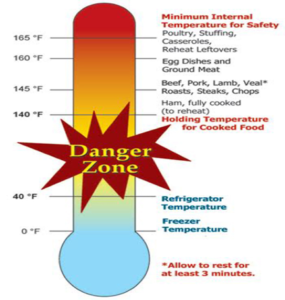All fields are required
Posted in Food Safety on May 27, 2018

Ah, summer, glorious summer.
Memorial Day has historically been the official kickoff day of the summer season. The kids are just getting out of school. Vacations are in the works. The weather is warm. And it is the time of year many are ready to get friends and family together and enjoy roasting meat over a barbecue. In fact, Seventy-seven percent of Americans will utilize their charcoal or gas grills, and sixty three percent choose to cook hamburgers, followed percentage-wise by chicken, steak, seafood, and vegetables.
Here at Make Food Safe, we want to make sure that you and your family stays healthy and happy this Memorial Day weekend (and every other weekend) during this summer season.
So, before us foodies place hamburger to grill, we have thought about ways we can pass on our knowledge to others. Because we believe the best way to help and keep others safe is to help others be well-informed and implement the best practices in food safety at each and every step.
Tips n’ Tricks
We have broken down some quick and simple ways everyone can help keep everyone safe!
Step One: Clean
The best way to be proactive about food safety is to know the importance of proper cleaning and sanitation before you begin to cook your culinary masterpiece(s).
Step Two: Avoid Cross-Contamination
Step Three: Properly Store Your Food Purchases
Step Four: Cook Your Meal
According to the Food and Drug Administration (FDA), follow these steps when cooking food:

It’s Not “Top Gun”, So Stay Out of the Danger Zone
Below is a handy guide in chart form that describes the proper temperatures for food.Never leave raw meat, poultry, or any perishable food, including mayonnaise, dairy products, or cream-based salad dressings out for longer than two hours. If the temperature is over 90°F, no more than one hour. Personally, I think it’s much better to err on the side of caution and put the food away right away.
If You Do Get Sick, Here’s What to Look For:
For the purposes of this article and in keeping it short, I’ll focus on the two most common types of foodborne illnesses, although there are many others. If you need more comprehensive information on virtually every type of foodborne illness, their symptoms and treatment, consult the website for the FDA (www.fda.gov) or the CDC (www.cdc.gov).
I’ve had a bout with foodborne illness, and believe me, it is no picnic (pun completely intended).
E. coli has unfortunately been in the news frequently. It is notorious for contaminating raw meat, especially undercooked hamburgers. It also makes its nasty appearance in salads, fruits, and raw sprouts. The bacteria incubate for one to ten days, and causes severe and often bloody diarrhea, severe abdominal pain, and vomiting. Usually there is no fever. In the elderly and the young and those with compromised immune systems, E. coli infection can result in a potentially deadly kidney disease called hemolytic uremic syndrome (HUS).
Salmonella is the most common form of a bacterial foodborne pathogen. It can be found most commonly in contaminated eggs, poultry, meat, raw fruits, and unpasteurized milk or juice, and cheese. The bacteria are killed by heating/cooking. Symptoms of a salmonella infection, like E.coli, include diarrhea, abdominal cramps, and vomiting. The duration of this type of infection typically lasts approximately four to six days.
The Mantra for Food Safety
Perhaps the single most important preventative measure you can take is to wash your hands frequently. Doctors, researchers, food safety experts, food safety websites, tinkers, tailors, soldiers and spies will all tell you the same thing, and it should be a mantra: wash, wash, wash, and wash your hands!
Have a wonderful holiday weekend! Be safe out there!
By: Kerry Bazany, Contributing Writer (Non-Lawyer)